
Blog by Dr Darren Cook, VISION Research Fellow in Natural Language Processing
Earlier this month, Dr Elizabeth (Lizzie) Cook and I had the opportunity to introduce our developing project on Domestic Homicide Reviews (DHRs) at the Vulnerability and Policing Futures Research Centre’s second annual conference in Leeds. The two-day event brought together academics, practitioners, and policymakers to explore the themes of reducing harm and strengthening justice.
In a session on Measuring Vulnerability: Harnessing Routinely Collected Data, we outlined how natural language processing (NLP) could be used to improve access to and analysis of the Home Office’s growing library of DHR reports. We highlighted both the opportunities and challenges of applying advanced computational methods to such sensitive material and set out our vision for building a tool to make the full corpus of DHRs more searchable. By improving searchability, researchers and policymakers can more effectively explore recurring themes and insights within the reports.
Our talk prompted thoughtful questions and constructive feedback from an interdisciplinary audience of around 30 participants, which will help shape the next stages of the project.
What are Domestic Homicide Reviews?
Domestic Homicide Reviews (DHRs) are reports that examine the circumstances surrounding a death resulting from suspected domestic violence or abuse. Introduced in the Domestic Violence, Crime and Victims Act (2004) and implemented in 2011, these reviews provide a detailed, chronological account of the victim and perpetrator. They are written in narrative form and aim to identify lessons that can be learned from a domestic homicide.
Since June 2023, over 600 reports have been made publicly available through an online repository with a view to improving transparency and to encourage greater opportunity for learning.
Why does access remain a challenge?
Despite the progress made with the repository, researchers and practitioners still face barriers that limit how effectively the reports can be used. In our talk, we focused on two key challenges: (1) At present, each report must be extracted individually, which is impractical for projects working across hundreds of documents, and (2) The repository’s search functions rely on a fixed set of tags added by the Home Office. Users cannot create new categories or adjust existing ones, which restricts the kinds of questions researchers can ask. As a result, while the reports are technically public, their full potential as a resource remains difficult to unlock.
Building better access
Our presentation built on earlier consultation work with public and third sector organisations, and we shared some of the next steps we are planning. These will be set out in more detail in an upcoming research protocol paper co-authored with Sumanta Roy, a member of our VISION Advisory Board and Head of Research, Evaluation & Development at Imkaan, and Ravi Thiara, VISION Co-Investigator and Professor at University of Warwick.
Our central idea is to explore the feasibility of creating a structured dataset that summarises the key features of the DHR library. This would capture information such as victim and perpetrator demographics, the commissioning body, safeguarding risks, recommendations, and missed opportunities.
To do this, we are developing a tool that applies text-mining and natural language processing (NLP) techniques to extract information directly from the reports. The resulting dataset will be both searchable and filterable, allowing users to focus on increasingly specific subsets of the material. We also want to build functionality that enables users to download customised sets of reports rather than relying on individual downloads.
How will this help researchers and policymakers?
By improving access, searchability, and flexibility, our project will make it possible to work with DHRs at a scale that has not previously been possible. Instead of relying on small samples or manual searches, researchers will be able to look across hundreds of cases, identify recurring patterns, and ask new kinds of questions. The creation of a structured dataset will also support more consistent and comparable findings, helping to strengthen collaboration between academics, practitioners, and policymakers.
In the longer term, we hope this work will not only make DHR research more efficient but also ensure that the lessons within these reports are more easily applied to safeguarding practice.
Looking back to the conference
Presenting at the Vulnerability and Policing Futures Conference gave us the chance not only to share our ideas but also to test them with an audience of experts. The thoughtful discussions and questions we received will help guide how we take this project forward.
For further information, please contact Darren at darren.cook@citystgeorges.ac.uk
Image from Adobe Stock subscription.

